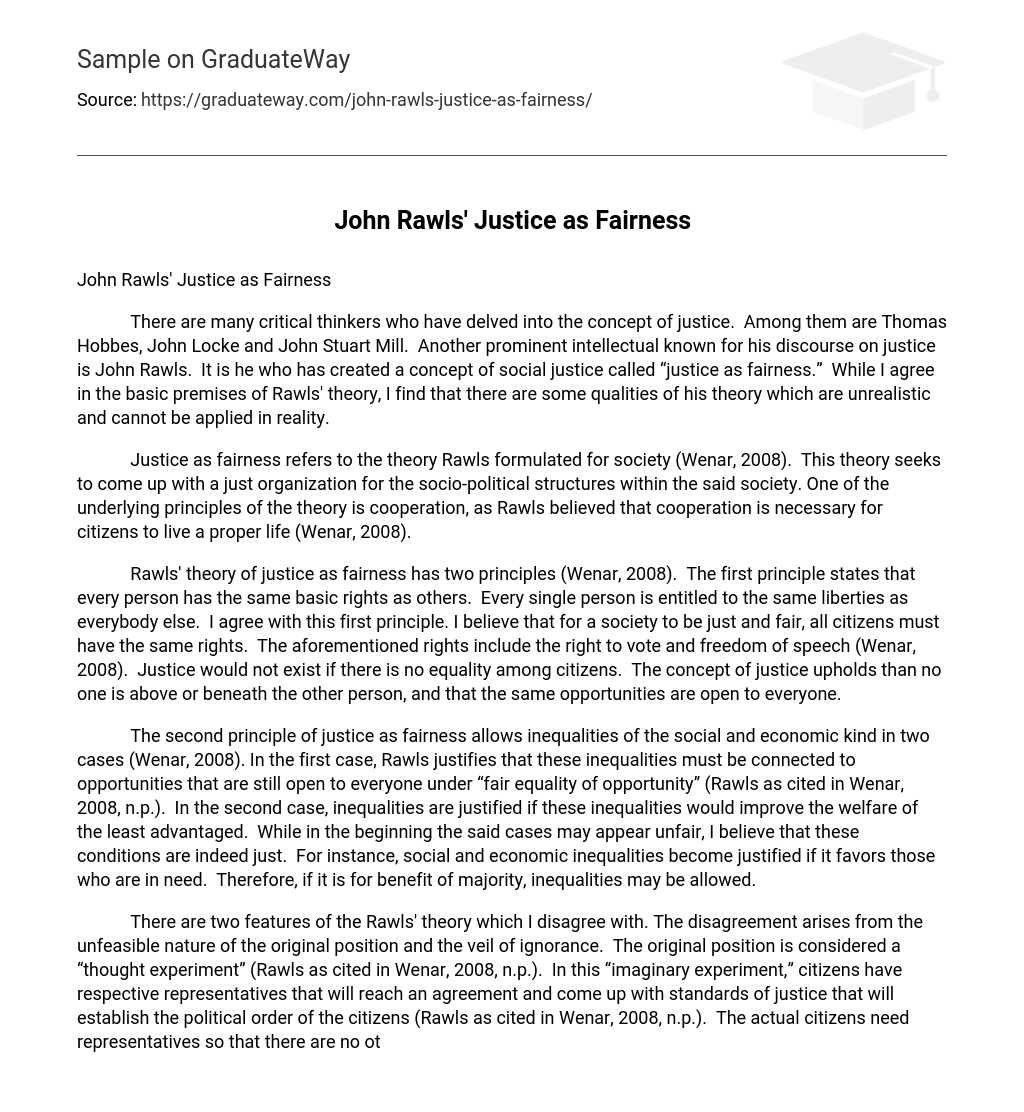There are many critical thinkers who have delved into the concept of justice. Among them are Thomas Hobbes, John Locke and John Stuart Mill. Another prominent intellectual known for his discourse on justice is John Rawls. It is he who has created a concept of social justice called “justice as fairness.” While I agree in the basic premises of Rawls’ theory, I find that there are some qualities of his theory which are unrealistic and cannot be applied in reality.
Justice as fairness refers to the theory Rawls formulated for society (Wenar, 2008). This theory seeks to come up with a just organization for the socio-political structures within the said society. One of the underlying principles of the theory is cooperation, as Rawls believed that cooperation is necessary for citizens to live a proper life (Wenar, 2008).
Rawls’ theory of justice as fairness has two principles (Wenar, 2008). The first principle states that every person has the same basic rights as others. Every single person is entitled to the same liberties as everybody else. I agree with this first principle. I believe that for a society to be just and fair, all citizens must have the same rights. The aforementioned rights include the right to vote and freedom of speech (Wenar, 2008). Justice would not exist if there is no equality among citizens. The concept of justice upholds than no one is above or beneath the other person, and that the same opportunities are open to everyone.
The second principle of justice as fairness allows inequalities of the social and economic kind in two cases (Wenar, 2008). In the first case, Rawls justifies that these inequalities must be connected to opportunities that are still open to everyone under “fair equality of opportunity” (Rawls as cited in Wenar, 2008, n.p.). In the second case, inequalities are justified if these inequalities would improve the welfare of the least advantaged. While in the beginning the said cases may appear unfair, I believe that these conditions are indeed just. For instance, social and economic inequalities become justified if it favors those who are in need. Therefore, if it is for benefit of majority, inequalities may be allowed.
There are two features of the Rawls’ theory which I disagree with. The disagreement arises from the unfeasible nature of the original position and the veil of ignorance. The original position is considered a “thought experiment” (Rawls as cited in Wenar, 2008, n.p.). In this “imaginary experiment,” citizens have respective representatives that will reach an agreement and come up with standards of justice that will establish the political order of the citizens (Rawls as cited in Wenar, 2008, n.p.). The actual citizens need representatives so that there are no other factors that will influence the process aside from the desire of the free and equal citizens (Wenar, 2008).
If justice as fairness theory is to be applied in reality, the original position would not work. I am aware that it is merely imaginary, but if one were to formulate a concept of justice for society, there would be no room for imagination. Citizens may be free and equal, but they have their own interests. It is in their nature to protect these interests. Having representatives may not work either; it is because the said representatives have their own interests as well. Citizens may seek equality and fairness, but in the end, they have needs they want to be addressed.
The veil of ignorance is another questionable idea for me. This veil is supposed to conceal factors that may affect the judgment of the said representatives. It is said that the purpose of this veil should conceal factors such as race, gender, financial status, and the like. Through the veil, the process of justice will be unbiased. The said factors may not be revealed, but each and every one of us has biases. We all have preconceived notions or opinions of people and things. These biases will work against the goal of fairness.
The theory of justice as fairness by John Rawls is great in idea, but difficult in application. It is a given that justice exists when everyone is equal and shares the same rights. It is also just if certain inequalities are allowed to favor those who are less fortunate. The flaw of the theory lies in the original position and the veil of ignorance. Both concepts are great in theory, but they cannot be applied in reality.
Reference
Wenar, L. Justice as fairness: justice within a liberal society. Stanford Encyclopedia of Philosophy. Retrieved July 2, 2008, from http://plato.stanford.edu/entries/rawls/#JusFaiJusWitLibSoc





